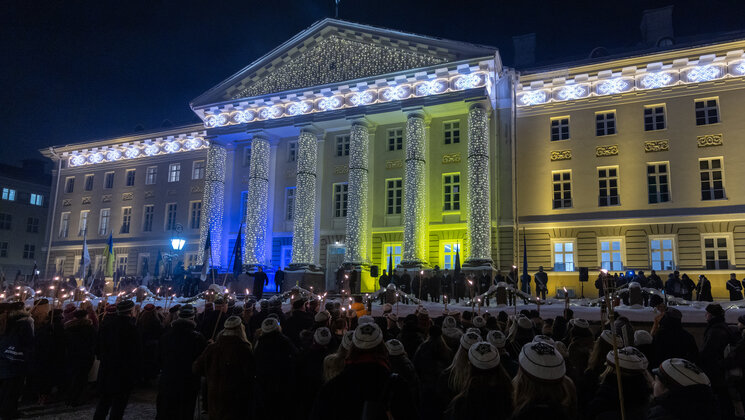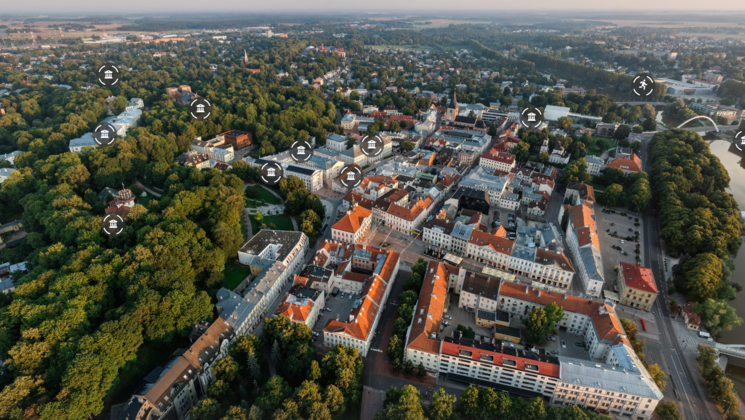-
Faculty of Arts and HumanitiesDean's Office, Faculty of Arts and HumanitiesJakobi 2 ruumid 116–121, 51005 Tartu linn, EST0Institute of History and ArchaeologyJakobi 2 51005 Tartu linn, Tartu linn, Tartumaa EST0Institute of Estonian and General LinguisticsJakobi 2, IV korrus 51005 Tartu linn, Tartu linn, Tartumaa EST0Institute of Philosophy and SemioticsJakobi 2, III korrus, ruumid 302-337 51005 Tartu linn, Tartu linn, Tartumaa EST0Institute of Cultural ResearchÜlikooli 16 51003 Tartu linn, Tartu linn, Tartumaa EST0Institute of Foreign Languages and CulturesLossi 3 51003 Tartu linn, Tartu linn, Tartumaa EST0School of Theology and Religious StudiesÜlikooli 18 50090 Tartu linn, Tartu linn, Tartumaa EST0Viljandi Culture AcademyPosti 1 71004 Viljandi linn, Viljandimaa EST0Professors emeriti, Faculty of Arts and Humanities0Associate Professors emeriti, Faculty of Arts and Humanities0Faculty of Social SciencesDean's Office, Faculty of Social SciencesLossi 36 51003 Tartu linn, Tartu linn, Tartumaa EST0Institute of EducationJakobi 5 51005 Tartu linn, Tartu linn, Tartumaa EST0Johan Skytte Institute of Political StudiesLossi 36, ruum 301 51003 Tartu linn, Tartu linn, Tartumaa EST0School of Economics and Business AdministrationNarva mnt 18 51009 Tartu linn, Tartu linn, Tartumaa EST0Institute of PsychologyNäituse 2 50409 Tartu linn, Tartu linn, Tartumaa EST0School of LawNäituse 20 - 324 50409 Tartu linn, Tartu linn, Tartumaa EST0Institute of Social StudiesLossi 36 51003 Tartu linn, Tartu linn, Tartumaa EST0Narva CollegeRaekoja plats 2 20307 Narva linn, Ida-Virumaa EST0Pärnu CollegeRingi 35 80012 Pärnu linn, Pärnu linn, Pärnumaa EST0Professors emeriti, Faculty of Social Sciences0Associate Professors emeriti, Faculty of Social Sciences0Faculty of MedicineDean's Office, Faculty of MedicineRavila 19 50411 Tartu linn, Tartu linn, Tartumaa ESTInstitute of Biomedicine and Translational MedicineBiomeedikum, Ravila 19 50411 Tartu linn, Tartu linn, Tartumaa ESTInstitute of PharmacyNooruse 1 50411 Tartu linn, Tartu linn, Tartumaa ESTInstitute of DentistryL. Puusepa 1a 50406 Tartu linn, Tartu linn, Tartumaa ESTInstitute of Clinical MedicineL. Puusepa 8 50406 Tartu linn, Tartu linn, Tartumaa ESTInstitute of Family Medicine and Public HealthRavila 19 50411 Tartu linn, Tartu linn, Tartumaa ESTInstitute of Sport Sciences and PhysiotherapyUjula 4 51008 Tartu linn, Tartu linn, Tartumaa ESTProfessors emeriti, Faculty of Medicine0Associate Professors emeriti, Faculty of Medicine0Faculty of Science and TechnologyDean's Office, Faculty of Science and TechnologyVanemuise 46 - 208 51003 Tartu linn, Tartu linn, Tartumaa ESTInstitute of Computer ScienceNarva mnt 18 51009 Tartu linn, Tartu linn, Tartumaa ESTInstitute of GenomicsRiia 23b/2 51010 Tartu linn, Tartu linn, Tartumaa ESTEstonian Marine Institute0Institute of PhysicsInstitute of ChemistryRavila 14a 50411 Tartu linn, Tartu linn, Tartumaa EST0Institute of Mathematics and StatisticsNarva mnt 18 51009 Tartu linn, Tartu linn, Tartumaa EST0Institute of Molecular and Cell BiologyRiia 23, 23b - 134 51010 Tartu linn, Tartu linn, Tartumaa ESTTartu ObservatoryObservatooriumi 1 61602 Tõravere alevik, Nõo vald, Tartumaa EST0Institute of TechnologyNooruse 1 50411 Tartu linn, Tartu linn, Tartumaa ESTInstitute of Ecology and Earth SciencesJ. Liivi tn 2 50409 Tartu linn, Tartu linn, Tartumaa ESTProfessors emeriti, Faculty of Science and Technology0Associate Professors emeriti, Faculty of Science and Technology0Institute of BioengineeringArea of Academic SecretaryHuman Resources OfficeUppsala 6, Lossi 36 51003 Tartu linn, Tartu linn, Tartumaa EST0Area of Head of FinanceFinance Office0Area of Director of AdministrationInformation Technology Office0Administrative OfficeÜlikooli 17 (III korrus) 51005 Tartu linn, Tartu linn, Tartumaa EST0Estates Office0Marketing and Communication OfficeÜlikooli 18, ruumid 102, 104, 209, 210 50090 Tartu linn, Tartu linn, Tartumaa EST0Area of RectorRector's Strategy OfficeInternal Audit OfficeArea of Vice Rector for Academic AffairsOffice of Academic AffairsUniversity of Tartu Youth AcademyUppsala 10 51003 Tartu linn, Tartu linn, Tartumaa EST0Student Union OfficeÜlikooli 18b 51005 Tartu linn, Tartu linn, Tartumaa EST0Centre for Learning and TeachingArea of Vice Rector for ResearchUniversity of Tartu LibraryW. Struve 1 50091 Tartu linn, Tartu linn, Tartumaa EST0Grant OfficeArea of Vice Rector for DevelopmentCentre for Entrepreneurship and InnovationNarva mnt 18 51009 Tartu linn, Tartu linn, Tartumaa EST0University of Tartu Natural History Museum and Botanical GardenVanemuise 46 51003 Tartu linn, Tartu linn, Tartumaa EST0International Cooperation and Protocol Office0University of Tartu MuseumLossi 25 51003 Tartu linn, Tartu linn, Tartumaa EST0
Virtual Reality for Journalism: U.S. and Baltic Country Highlights
Virtual Reality for Journalism: U.S. and Baltic Country Highlights
Tuesday, September 29, 2020
3:30 – 5:00 p.m. (Riga time)
The Virtual Reality for Journalism: U.S. and Baltic Country Highlights workshop will highlight best practices and innovations related to current or future application of augmented and virtual reality in journalism and journalism curriculum. The workshop will provide faculty and students across Baltic universities with the opportunity to learn about practical ways that AR/VR are being integrated into journalism in the U.S. and Baltic contexts. Through discussion, the workshop will also consider how AR/VR can potentially be used in building resilience to disinformation.
Agenda
3:30– 3:40 p.m. Welcome and Introductions
3:40 – 4:10 p.m. Keynote: Using AR and VR in Journalism Storytelling
Yuliya Parshina-Kottas, Immersive Experiences Designer & Visual
Storyteller, The New York Times
4:10 – 4:40 p.m. University Presentations
Deepfakes and AR/VR, Kristjan Kikerpill, University of Tartu, Estonia
Virtual Reality Studies at Vidzeme University of Applied Sciences, Dr. Arnis Cīrulis, Vidzeme University of Applied Sciences, Latvia
Journalism in the 21st Century: How to Embrace VR and AI, and Become/Remain a Journalist, Prof. Tomas Krilavičius, Vytautas Magnus University, Lithuania
4:40 – 5:00 p.m. Moderated Discussion, Questions and Answers
Please click on this link to register by September 25, 2020. Upon registering, you will receive the ZOOM link by email to attend. The workshop is open to current faculty and students in the Media Literacy in the Baltics Program, as well as other interested universities and partners in Estonia, Latvia, and Lithuania.
The Media Literacy in the Baltics Program is a program of the U.S. Department of State and administered by IREX.
Speaker Biographies
Yuliya Parshina-Kottas, United States
Yuliya Parshina-Kottas is an award-winning designer, researcher and visual storyteller using emerging tech to engage audiences in digital and physical spaces. She draws on 15 years of experience in interaction design, motion graphics, and 3D to take projects from initial ideation through complete technical production. As part of the New York Times Graphics department, Ms. Parshina-Kottas develops and produces immersive and datadriven stories for the newsroom, using AR, VR and interactive 3D. Her previous work includes interactive experiences, spatial installations and motion design for cultural institutions, digital advertising campaigns and children’s television.
Kristjan Kikerpill, Estonia
Kristjan Kikerpill is a doctoral student at the Institute of Social Studies (University of Tartu, Estonia). His main areas of interest and research are online deception, the mechanics of phishing and other cybercrimes, the social impact of deepfakes, and crime prevention in online environments.
Dr. Arnis Cīrulis, Latvia
Dr. Arnis Cīrulis wears many hats at Vidzeme University of Applied Sciences (ViA), embracing academic, research, and administrative roles. His specialty is augmented and virtual reality (AR/VR) technologies. Alongside his research work, which is dedicated to dynamic 3D visualization in outdoor augmented reality modes, Arnis shares his insights with students, working as an Associate Professor at ViA. He has developed and heads the only master’s program specializing in AR/VR in Latvia, “Virtual Reality & Smart Technologies. “
Prof. Tomas Krilavičius, Lithuania
Prof. Tomas Krilavičius is head of the Applied Informatics department at Vytautas Magnus University. His research interests include applications of Artificial Intelligence and Languages in industry, medicine, security, and defense, large scientific infrastructures. Tomas is a NATO STO IST panel member, country governmental expert at CapTech Information. He is co-founder of several companies (Tokenmill, UAB; Analitika and co,
UAB (DICHECK)).
For questions regarding the workshop, please contact Kaspars Rūklis (IREX/Latvia): kruklis@irex.org or Stanley Currier (IREX/DC): scurrier@irex.org.
Read more similar news





